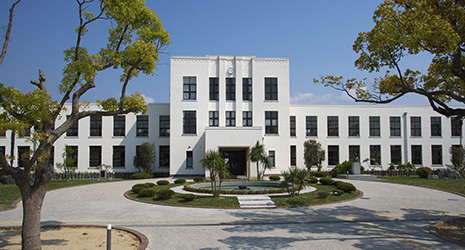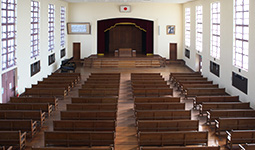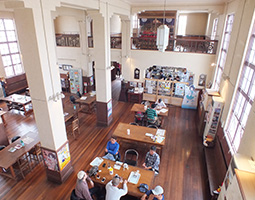Home > Highlighting JAPAN >Highlighting Japan June 2016>Living Heritage
Highlighting JAPAN


A Model School
When fans of K-On! recognized the former building of Toyosato Elementary School as the real-life model for the setting of the best-selling manga and anime series, pilgrimages to the site quickly followed.
The former building of Toyosato Elementary School in the town of Toyosato, Shiga Prefecture was built with funding from local businessman Tetsujiro Furukawa (1878–1940) and designed by the American entrepreneur and missionary William Merrell Vories (1880–1964). Completed on 30 May 1923, the building is made of ferroconcrete, which was quite unusual for the time, and was said to be “the best elementary school in the East” and known as “the white educational house” because it had a swimming pool, an auditorium and a library as well as central heating and first-class educational equipment.
The building fell into disuse when the elementary school changed locations and was slated for demolition, but as a result of energetic efforts by local residents it was eventually preserved. Large-scale renovation work on the site commenced in 2008, and today the building houses a municipal library, a childcare facility and a senior citizen support center.
When the building reopened on 30 May 2009, the same date as the building’s initial completion, local residents and officials were surprised to see many young people they had never seen before in attendance. Toyosato is a small town with a population of about 7,400 who engage mainly in agriculture, and was seldom visited by tourists until that time. The youngsters, they soon discovered, had flocked to Toyosato on a “pilgrimage” to the setting for the popular manga and anime series K-On!
On April 9, one month before the reopening of the former school building, the first instalment of the anime series K-On! was broadcast on TV. Anime enthusiasts began to speculate on social media that the school building in the series was modeled on Toyosato Elementary School, the preservation efforts of which had been covered extensively in the news. Thereafter, anime enthusiasts not just from Japan but from around the world began to make pilgrimages to the school. Initially at a loss, local residents and the town government warmed to the tourism trend and in June, one month after the building’s reopening, established the Steering Committee for Town Revitalization by K-On!. They opened a café in the old library, and in 2011 began to hold the Toyosato Live Concert Contest in the auditorium, a music festival for high school student bands. After national auditions, five bands are invited to compete in the festival with the winner being awarded the Minister of Education, Culture, Sports, Science and Technology Prize.
In 2013, as the school attracted more and more attention as a pilgrimage destination, the old building of Toyosato Elementary School was designated as a tangible cultural property.
In November 2014, Toyosato hosted the Nationwide Anime Sacred Spot Summit. By then, some 300,000 anime enthusiasts had visited Toyosato, and 20,000 people still visit the town every year.
“I am excited to see the real school model with my own eyes,” said one K-On! enthusiast on the grounds of the old school. “This is a perfect spot for shooting cosplay pictures,” said another.
Special birthday events for anime characters have also been held in response to requests from anime enthusiasts, and there are no signs of any decline in the old building’s popularity.
© 2009 Cabinet Office, Government of Japan








